Van Gogh Museum Journal 1996
(1996)– [tijdschrift] Van Gogh Museum Journal–
[pagina 56]
| |
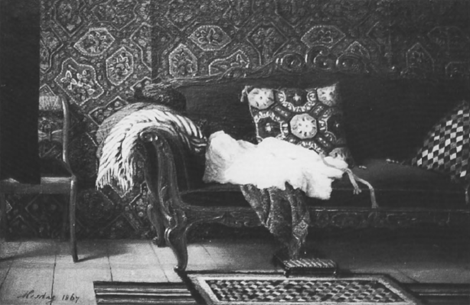 fig. 1
Hendrik Willem Mesdag, An interior, 1867, private collection (photograph courtesy of Stichting Mesdag, Wassenaar) | |
[pagina 57]
| |
Cousins and colleagues: the lives of Hendrik Willem Mesdag and Lawrence Alma-Tadema
| |
[pagina 58]
| |
dream: he became a painter.Ga naar voetnoot5 As he wrote his cousin Lawrence, who was painting in Brussels, in the spring of 1866: ‘I'm 35 years old. I've a wife and child. I've been trained for business, but am not cut out for it. I'm a painter; help me.’Ga naar voetnoot6 Judging from Alma-Tadema's answer of 22 April, he acted as a mediator between Mesdag and a Dutch colleague, Willem Roelofs (1822-1897), who had been living in Brussels ever since 1847.Ga naar voetnoot7 Roelofs was prepared to take Mesdag on as a pupil for 1,200 francs a year. A comment he made in a letter at about that time suggests that it was the financial aspect of the arrangement that most interested him: ‘In the autumn (September) I'm expecting a new pupil, a cousin of Tadema, Mr Mesdag from Groningen. The 1,200 francs His Honour gives me is nothing to sniff at.’Ga naar voetnoot8 Alma-Tadema was pleased with his cousin who, having embraced the same profession, had become ‘doubly interesting’ to him.Ga naar voetnoot9 On 21 May 1866 he wrote Mesdag that while he had not spoken to Roelofs again, he was convinced ‘the deal has been clinched, given the fact that both sides have accepted the conditions without comment.’ Alma-Tadema was writing from London, where he and his wife were visiting friends for ‘some distraction.’ In the end, however, he got more of it than he bargained for. He was staying with the eminent art dealer Ernest Gambart, with whom he had signed a contract in 1864. Gambart had organised a fancy-dress ball for the evening of 16 May and invited the international beau monde. Gas lamps were installed especially for the occasion. In his letter to Mesdag, Alma-Tadema described what happened on the day of the party: ‘A great misfortune has befallen the friends with whom we were staying [...]. Last Wednesday, at eight in the morning, a gas explosion all but demolished their house and its magnificent furnishings. None of us were harmed, but some of the servants were not so lucky. Two of the chambermaids were seriously injured, one of whom has meantime died from her wounds. The gardener was also very badly hurt, while the coachman and the groom were seriously injured as well. [...] Fortunately we were still in bed when all of a sudden we saw our furniture partly destroyed and daylight streaming through a terrible crack in the wall.’Ga naar voetnoot10 As Alma-Tadema assured Mesdag, he ‘would not willingly go through such an experience again.’ Yet his own house in London suffered a similar blow when a ship loaded with gunpowder exploded in 1874. | |
Mesdag and Alma-Tadema in BrusselsBefore setting off for Brussels, Mesdag and his wife went to Oosterbeek to paint en plein air. Roelofs had received a letter from Mesdag in the meantime, to which he replied from Brussels on 27 May 1866: ‘As I've already told Alma-Tadema, nothing would give me greater pleasure than helping you with your study of landscape, and I hope to be able to stimulate you to make progress in our art.’ Roelofs heartily approved of Mesdag's plan to spend the summer making sketches directly from nature, ‘since, if you were here, I could advise you to do nothing better.’ | |
[pagina 59]
| |
The first lesson began immediately: ‘Try and rid yourself of all so-called manner and, in a word, try and imitate nature with feeling, but without thinking about others' work. Paint studies of parts, a bit of land for instance, a stand of trees or something of the kind, but always in such a way that it can be grasped in connection with the entire landscape [...]. - These studies [are] in order to become acquainted with nature bit by bit. - Further studies of a whole, preferably very simple subjects. - A meadow with the horizon and a bit of sky [...]. Paint all these studies not so you can bring home something beautiful [...] but for yourself.’Ga naar voetnoot11 In September 1866 Mesdag arrived in Brussels, where he would remain for three years. At first he painted as Roelofs and Alma-Tadema had advised him to do. Now and then Roelofs went to visit the aspiring artist in his studio, which is apparently where the lessons took place.Ga naar voetnoot12 As the remarks quoted earlier clearly indicate, Roelofs, himself a landscape painter, placed particular emphasis on the study of landscape, and especially on colour and technique.Ga naar voetnoot13 Yet most of Mesdag's paintings from his Brussels period are detailed figure studies or portions of interiors. His penchant for meticulous observation can be attributed in part to his contact with such Brussels Realists as Louis Dubois and Alfred Verwee.Ga naar voetnoot14 More than anything else, however, it betrays Alma-Tadema's influence, as was already apparent to Anna Croiset, a good friend of the Mesdags: ‘They have survived, those dry but nonetheless fruitful studies. Strikingly accurate and scrupulously detailed, they evince stubborn patience and unfailing loyalty to the lofty principle: representing nature as one observes it, down to the most minute details. That was indicative of Alma-Tadema's point of view.’Ga naar voetnoot15 Alma-Tadema had concentrated on figure pieces which included all the particulars of the setting. One canvas that clearly illustrates Mesdag's debt to his cousin is An interior, painted in 1867 (cf. figs. 1 and 2).Ga naar voetnoot16 The carved wood of the couch and the motifs of the various fabrics and carpets are depicted with the greatest precision. His series of street scenes, in which every stone in the pavement and the walls is shown with equal precision, likewise recalls Alma-Tadema's painstaking manner (fig. 15). | |
‘Painting won't take orders from anyone’In two letters from 1867 (the only ones by his hand that the Museum Mesdag preserves) Mesdag, in turn, advised his friend A.J. van Prooijen in Groningen on painting. His comments reveal which of his cousin's views he had absorbed.Ga naar voetnoot17 Dated 7 January 1867, by which time Mesdag had been in Brussels for over three months, the first letter is a response to one from Van Prooijen of 20 December 1866 on his work. During the previous summer the two men had apparently discussed painting at length in Oosterbeek. Mesdag wrote of his discovery that even ‘great’ artists had to struggle: ‘I've now observed three really great masters working at close range, namely Bilders,Ga naar voetnoot18 Tadema and Roelofs, and all three of them have to fuss and slave over | |
[pagina 60]
| |
 fig. 2
Lawrence Alma-Tadema, Preparations for the festivities, 1866, Williamstown, Mass, Sterling and Francine Clark Art Institute their work just as much as we do, and often even more.’ He continued to believe that ‘rich tone and depth can only be got working constantly on a piece,’ a notion that derived from Roelofs: ‘Roelofs's advice is to paint thickly by all means, that is, to apply plenty of paint, preferably without oil or turpentine [...]. I hope you understand what I'm saying: not thick colours, for of all people he is the one who achieves that haze and those powerful colours only by over painting repeatedly.’ Mesdag thought it essential to ‘just to keep grinding away,’ to work a lot and learn a lot, ‘that's all I intend to do. [...] I'm still working on my still life - and four weeks ago I thought it was almost done. I work on it daily from nine in the morning until four in the afternoon and it's still far from finished. It's while one is actually working that one realises repeatedly how much more powerful nature is in the end, and that one can only expect to arrive at halfway matching colours by painting something over and over again.’ It is best ‘to keep on searching [...]. Whenever I ask Roelofs and Tadema what manner of painting I should follow, they both say we can't say anything about that, we ourselves don't know how pictures get painted, now one way and then another. Always follow your intuition at the moment; painting won't take orders from anyone.’Ga naar voetnoot19 In the second letter, dated 2 November 1867, Mesdag reiterated the importance of painting from nature. He kept on making studies because he had not yet managed to produce a painting ‘that was really good. That's why I just go on painting pieces after nature. It can be a piece of ground, a flower, some grass, or some such thing; or something from my studio or a stairway landing. So whenever | |
[pagina 61]
| |
you're not working on your paintings, do what I do, for instance: from your window a view of the river A - of a ship or something, and I think you'll see for yourself how different it becomes and how powerful the colour gets.’Ga naar voetnoot20 These last tips in particular can probably be traced to Alma-Tadema. Making a study of a corner of his atelier, including a detailed rendition of the fabrics and motifs, coincides with Alma-Tadema's approach. Laura and Nellie Epps, who later began painting under Alma-Tadema's watchful eye as well, worked in the same fashion (figs. 11-14). Whereas Mesdag had a view of the street in Brussels, Van Prooijen looked out on the water. The point was to reproduce a slice of carefully observed reality, framed by the window. The idea of painting a stairway landing certainly stems from Alma-Tadema, who had often done so when he was starting out.Ga naar voetnoot21 It was a good exercise not only in perspective, but also in rendering shadow and light (fig. 3). Mesdag was also busily studying perspective, which he found ‘not so amusing’ but important. Though he had obviously made progress, he felt he still had a long way to go: ‘Meanwhile I'm gradually beginning to place greater demands on myself, which is why I'm less satisfied with my work. Yet I always enjoy working, and hope that with perseverance I'll someday learn how to make a good painting, which demands so much time that one really despairs of ever getting that far.’ The artist concluded his letter with good advice, revealing something of his business sense: ‘Work as much as possible with pleasure and good cheer. Try making drawings in the evening, and apply yourself: at least they are easier to sell than paintings.’Ga naar voetnoot22 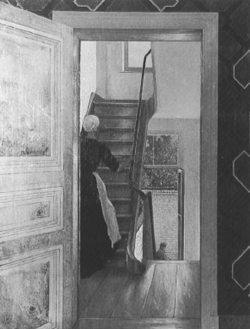 fig. 3
Hendrik Willem Mesdag, Interior with stairs, 1868, The Hague, Panorama Mesdag | |
[pagina 62]
| |
BreakthroughIn the meantime, Alma-Tadema's star was rising. At first he painted scenes set in the Middle Ages and in ancient Egypt; later on he preferred Classical Antiquity. He received awards, including a gold medal at the Tentoonstelling van Levende Meesters in Amsterdam as early as 1862; in 1867 he was represented at the Exposition Universelle in Paris with 14 pictures, all but one of which belonged to his dealer Ernest Gambart. His prices rose commensurate with his fame. In 1868 he submitted two pictures to the Exposition de la Bienfaisance in Brussels, for which he asked high prices. Roelofs was rather disdainful, but perhaps also somewhat jealous: ‘Alma Tadema has also deigned to send a couple [of pictures], one that's been in Arti - not very good - and another bit of trash he threw some extra paint on for the occasion. His pretentiousness beats everything and his prices are absurd: 12òòò francs! and the little one for 3óóó!’Ga naar voetnoot23 Alma-Tadema submitted a painting to the Paris Salon that same year: La siesta en Grèce (Madrid, Prado). By this time his fame was greater in Paris than in Holland or Belgium. Indeed he claimed that a French amateur who expressed interest in his pictures did so more out of a desire ‘to own one of my works than because he admired it.’ He received good notices and no less than four caricatures of his painting had already been made, ‘something that makes one famous. [...] Everyone knows me there.’ Yet he was dissatisfied with the head of the old man in his Salon painting: it seemed ‘to be any old man one might come across in the street. So I got a brush and spent a few mornings in the Louvre studying some ancient Greek heads.’Ga naar voetnoot24 Mesdag, too, was gradually becoming an independent talent. By January 1869 things were apparently going so well for him that he was overdoing it in his father's eyes. This called for a bit of paternal advice: ‘Now that you're being successful you're on a slippery road. Ambition is absolutely necessary but can also get out of hand.’Ga naar voetnoot25 Following a sojourn on the German island of Norderney, where he discovered the sea as a subject for painting, in the spring of 1869 Mesdag decided to settle in The Hague, in order to have his favourite motif close at hand.Ga naar voetnoot26 His breakthrough came in 1870, when his Breakers in the North Sea (Wassenaar, Collection J. Poort) won a gold medal at the Paris Salon. Thereafter he devoted himself primarily to marine pieces and his brushwork became looser. After the death of his wife Pauline in May 1869, Alma-Tadema did not do much more painting. His own health was poor and at the suggestion of his dealer Ernest Gambart, he went to London in December of that year for an operation. While he was there, it was through the English painter Ford Madox Brown that he met one of Brown's pupils, Laura Theresa Epps (1852-1909), and fell in love with her on the spot. The second time Alma-Tadema saw the young woman, he is said to have asked in his broken English: ‘Vy have I never seen any of your paintings? I know the work of both your sisters and dey are very goood [sic]!’ To which Laura replied, ‘You haven't seen any because I haven't done any! I am not a painter I am a musician.’ ‘I'm sure you be able to draw and paint,’ countered Alma-Tadema. ‘Vy not let me give you some lessons. I shall teach you how to paint!’Ga naar voetnoot27 They married in 1871. | |
[pagina 63]
| |
Before Alma-Tadema left Brussels for London he received an interesting request from the Home Secretary in The Hague. Thanks to a letter he wrote to Mesdag we are well informed about it, since he enclosed a copy of his answer to the minister. Though Alma-Tadema's letter is not dated, it must have been written in Brussels in May or June 1870. The Home Secretary had asked him to become director and professor (‘directeur 1o Hoogleeraar’) at the Rijksacademie that was to be established in Amsterdam.Ga naar voetnoot28 Alma-Tadema's refusal was somewhat hesitant: ‘Having pondered the matter for some time I must admit that it would be daring indeed for a young person such as myself, who is busy finding his way and thus still [has] little experience and only modest talent at his disposal, to place himself at the head of the art academy which officially must be considered the first of our country.’ To the copy of his reply to the minister he sent Mesdag he added: ‘I think it's important that people in Holland know what I have written, for my words could be misinterpreted. Therefore please keep the enclosed in case it is needed.’Ga naar voetnoot29 His designation of Mesdag as his spokesman in Holland would seem to suggest a certain vanity on Alma-Tadema's part. Despite his misgivings, it appears that Alma-Tadema was interviewed for the post nonetheless. On 2 July Mesdag informed a mutual friend, the Belgian painter Alfred Verwee, that Alma-Tadema had been in the Netherlands and that he could understand why he had declined the appointment.Ga naar voetnoot30 We may assume that Alma-Tadema had no regrets about his decision to become a painter. In September 1870 he left for London once and for all, taking with him his two daughters and his sister Artje. A brilliant future lay ahead of him.Ga naar voetnoot31 | |
Overseas contactsAlthough Alma-Tadema and Mesdag were now living at quite some distance from one another, the quantities of notes and letters that have survived show that they stayed in close touch. In the 1870s they saw one another regularly. During these visits they inevitably discussed artistic matters. Together with his brother-in-law Sam van Houten, Mesdag had a house built on the Laan van Meerdervoort in The Hague, containing studios for both himself and his wife (fig. 4).Ga naar voetnoot32 It was in this house that Lawrence and Laura, who had recently married, stayed with them in August 1871. As for Alma-Tadema, he bought Townshend House in London, near Regent's Park. His dealer Ernest Gambart introduced him to the artistic and cultural life of London. As he proudly wrote his friend Verwee even before settling in the capital, ‘Je connais déjà toute la clique préraphaëlite.’Ga naar voetnoot33 Not only did the Alma-Tademas attend other people's soirees, they also organised their own ‘At Homes.’ Frequently attended by celebrated guests, these weekly gatherings were spent conversing, dining and concertising. The company was always international: ‘This afternoon (Monday) was our reception as usual, when I must speak so many languages one after the other that it sometimes comes out all jumbled up.’Ga naar voetnoot34 | |
[pagina 64]
| |
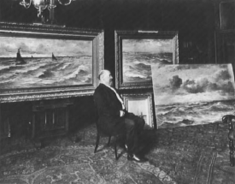 fig. 4
Mesdag in his studio, c. 1904, The Hague, Panorama Mesdag Alma-Tadema's circle of friends included the literary scholar and archeologist Carel Vosmaer (1826-1888), who, like Mesdag, lived in The Hague.Ga naar voetnoot35 The artist often turned to him for information about ancient details in his pictures. With the help of the opus numbers Alma-Tadema assigned to his paintings and watercolours, Vosmaer began to assemble a catalogue of his friend's oeuvre, but died in 1888 before he could finish the task. The unpublished manuscript is still a mine of information about Alma-Tadema's work.Ga naar voetnoot36 On 26 July 1871, Alma-Tadema wrote Vosmaer that he planned to wed in three days' time. ‘On Saturday [29 July] I'm getting married, and will be in The Hague from 8 until 15 August to visit my friend Vosmaer, naturally.’Ga naar voetnoot37 On this first stay with the Mesdags, however, the couple remained not a week but a month. Alma-Tadema did little work at the time; he was on his honeymoon, after all.Ga naar voetnoot38 It was probably then that he painted the small portrait of his wife Laura that is still in the Museum Mesdag (fig. 9). In 1872 Mesdag paid a return visit to the Alma-Tademas, which was his first exposure to London.Ga naar voetnoot39 Then in December 1872 Alma-Tadema and his wife arrived unexpectedly on the Mesdags' doorstep and stayed two days. In his friend's honour. Mesdag organised a dinner party to which he also invited Vosmaer: ‘Our friend Alma-Tadema has arrived here unexpectedly with his wife: he is staying until Saturday; would you and Madame do us the pleasure of coming to dine with us tomorrow afternoon at five?’Ga naar voetnoot40 | |
[pagina 65]
| |
It is not known whether the two couples visited one another in 1873. Two letters from Laura Tadema to Sientje Mesdag have been preserved, illustrated with composition sketches and a caricatural drawing (fig. 5).Ga naar voetnoot41 In the second she writes about Tad (as she called him), about his work and the fact that she and her sister Nellie had had three and a half hours of perspective lessons from him, using the base of a column. She also enthusiastically described the remodelling of their house: her studio had become ‘exceedingly pretty,’ furnished entirely in 17th-century Dutch style. The room had become available when her sister-in-law Artje, who had lived with them, ‘steamed off’ to Puerto Rico to get married. According to Alma-Tadema she was very content there; her letters fairly ‘burst the envelopes, there is so much happiness described in them.’Ga naar voetnoot42 To judge from a letter Artje wrote her cousin Hendrik Willem Mesdag from Puerto Rico, the Mesdags were back in London in the spring of 1874. The same letter makes it clear that the Alma-Tademas thoroughly enjoyed their visits.Ga naar voetnoot43 But Mesdag's motives for visiting London were not solely personal: he always tended to his commercial interests as well. On 20 January 1870 the artist wrote Verwee that he thought establishing oneself in England was important.Ga naar voetnoot44 Though he started negotiations with London art dealers at this point, it was not until 1871 that Mesdag began doing serious business with them and that his work was regularly shown in galleries and exhibitions. On 30 July 1871 he wrote with evident self-assurance that he had no doubts about his future there.Ga naar voetnoot45 ‘Visiting your exhibition I hope to see that my pictures look so well as you say’ was how he announced his arrival on more than one occasion;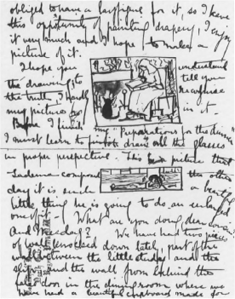 fig. 5
Page from a letter from Laura Tadema-Epps to Sientje Mesdag-van Houten, 25-26 October 1873, The Hague, Algemeen Rijksarchief | |
[pagina 66]
| |
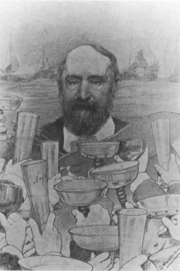 fig. 6
Lawrence Alma-Tadema, Menu in honour of Mesdag's 70th birthday, 1901, The Hague, Panorama Mesdag (present location of the original drawing unknown) the dealers in this case were Wallis & Son,Ga naar voetnoot46 but there is a copy of a similar letter addressed to Pilgeram & Lefèvre, in which he gave Alma-Tadema's house as his London address.Ga naar voetnoot47 His contacts with these dealers had begun already in 1870. In 1867 Henry Wallis had taken over Ernest Gambart's French Gallery, Pall Mall. Léon Lefèvre, a nephew of Gambart, and F.J. Pilgeram assumed the management of Gambart's King Street gallery in January 1870.Ga naar voetnoot48 Most likely Alma-Tadema was instrumental in bringing his cousin into contact with these dealers, who after all were the successors of Gambart, his own promoter in England. In the summer of 1874 the Alma-Tademas may have returned to The Hague again, en route to Germany.Ga naar voetnoot49 And Mesdag appears to have been in London a year later for the spring exhibitions at the Wallis Gallery and the Royal Academy.Ga naar voetnoot50 There is thus reason to believe that the friendship between the two artists was still alive. Regarding a debt Vosmaer owed him at one point, Alma-Tadema suggested that he ‘give it to Mesdag when you have the chance, since I always have something to settle with him.’Ga naar voetnoot51 On another visit to the continent in November 1875, the Alma-Tademas may have stopped in The Hague again; they were certainly there in early January 1877, for the wedding of a niece of Alma-Tadema's.Ga naar voetnoot52 Not much correspondence has survived subsequent to 1877, but Alma-Tadema's letters to Vosmaer make it clear that he was still in regular contact with Mesdag. There are occasional indications that they saw one another from time to time, such as a postcard from Mesdag in 1879 announcing | |
[pagina 67]
| |
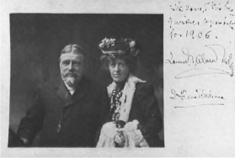 fig. 7
Lawrence Alma-Tadema and Laura Tadema-Epps, New Year's wishes for 1906 to the Mesdags, 1905, The Hague, Panorama Mesdag that ‘This spring we took a trip to Brussels, Paris, London and saw a great many pictures ... including some really bad ones.’Ga naar voetnoot53 That same year, in the autumn, Alma-Tadema was in The Hague, again on his way to Germany. Together with Mesdag, he attended an editorial meeting of De Nederlandsche Spectator; Vosmaer played an important role in this periodical.Ga naar voetnoot54 During this visit, the two artists may have discussed an exhibition of work by members of the Hollandsche Teeken-Maatschappij at Grosvenor Gallery, which had been arranged through Alma-Tadema.Ga naar voetnoot55 Though there is little evidence that Alma-Tadema and Mesdag were still in touch in the following decades, we may assume they were. It stands to reason that the contact would not have been as close as before: by this period, both artists had acquired international reputations, which must have placed considerable demands on their time. In 1885 Alma-Tadema moved to a larger house in Grove End Road, which he extensively remodelled to make even more luxurious. By 1888 he was ready to receive guests such as Mesdag and Vosmaer. ‘Here we are now at 17 Grove End Rd.,’ he wrote the latter in the spring. ‘Not yet completely installed, but enough to express the hope that you and your wife will honour us with a visit. Mesdag has already promised to come in May. May I therefore ask that you discuss the matter with them to make certain you are here at the same time, and that you provide us with some pleasant, memorable days enjoying art and friendship together?’Ga naar voetnoot56 As it happened Vosmaer died three months later, before he could take Alma-Tadema up on his invitation; is not known whether Mesdag ever visited his cousin in his new house. In 1901 Alma-Tadema served on the committee formed to organise the celebration of Mesdag's 70th birthday. For the menu he drew a portrait of his cousin wreathed by raised glasses (fig. 6).Ga naar voetnoot57 In 1905 the Alma-Tademas sent a photograph of themselves with best wishes for the New Year (fig. 7), and three years later Laura wrote Sientje a long letter to thank her for ‘the Hague biscuits’ and bring her up to date on family news.Ga naar voetnoot58 The last letters date from 1909 and 1911. In 1909, Laura Tadema sent Mesdag a letter of condolence | |
[pagina 68]
| |
 fig. 8
Lawrence Alma-Tadema, Boating, 1868, The Hague, Museum Mesdag following the death of his wife: ‘we did love her, and are sad that it is so many years since we saw her.’Ga naar voetnoot59 Laura herself died that same year. Alma-Tadema wrote his cousin about her illness and about what a heavy blow her death had been to him: ‘precisely three weeks ago the best of all women passed away, for me at least that's what she was entirely.’Ga naar voetnoot60 In an interview he gave in 1911, Alma-Tadema spoke of having visited Mesdag recently in The Hague.Ga naar voetnoot61 That was to be the last time they saw one another. Alma-Tadema died in 1912, Mesdag in 1915. | |
Mesdag and Alma-Tadema as collectorsBoth Mesdag and Alma-Tadema were insatiable collectors. Their houses were richly furnished and Alma-Tadema in particular was fond of combining the most divergent styles. In 1877 he still had to think twice about purchasing two antique embroidered cushions: ‘10 guilders will buy a lot of potatoes. I mustn't spend so much on antiques.’Ga naar voetnoot62 At the time of his death, however, his collection of objets d'art and pictures comprised over 1,500 items.Ga naar voetnoot63 Mesdag collected primarily Barbizon and Hague School | |
[pagina 69]
| |
paintings. At its earliest stages his taste was apparently formed in part by his younger, but more worldly, cousin; as Anna Croiset put it: ‘there is reason to believe the friendship with Tadema and his family caused Mesdag's taste and artistic sense to develop and improve.’Ga naar voetnoot64 In 1887 Mesdag's collection was so large that he had to build a museum beside his house on the Laan van Meerdervoort, which he later presented to the state: in 1903 it became the Rijksmuseum H.W. Mesdag.Ga naar voetnoot65 After his death in 1915, his estate was sold.Ga naar voetnoot66 Alma-Tadema and Mesdag also collected one another's work, as well as work by other members of their collective family. As early as 1868, when Mesdag was still living in Brussels, he had his eye on Alma-Tadema's picture The education of the children of Clovis (private collection), which was completed in October of that year. Apparently he wrote his father that he wanted to buy it. Mesdag senior, himself an art collector, was not surprised: ‘that his new Clovis makes your mouth water I can easily imagine and understand, but I must advise you against such things.’ He also took the opportunity to give him the practical advice of shortening the lessons his son Klaas was receiving, so that ‘the Master will speak just as much but cost you less money.’Ga naar voetnoot67 The father presumably objected to the purchase because Hendrik had bought another work by Alma-Tadema shortly before, which now belongs to the Museum Mesdag: Boating (fig. 8) is an anecdotal scene of Roman life, showing a young Roman drawing a skiff closer to the water's edge for his beloved. Alma-Tadema's first wife Pauline probably modelled for the Roman lady. The palette of this early work is still moderate, whereas that of his later pictures is brighter and more vibrant. Judging from an X-ray, the picture was painted over another, entirely different scene. A second acquisition was the previously mentioned portrait of Laura Tadema, which Alma-Tadema presented to Sientje (fig. 9). The work dates from August 1871, while the Alma-Tademas were on their honeymoon. It was probably painted at the home of the Mesdags,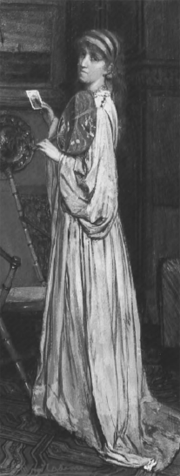 fig. 9
Lawrence Alma-Tadema, The artist's wife, 1871, The Hague, Museum Mesdag | |
[pagina 70]
| |
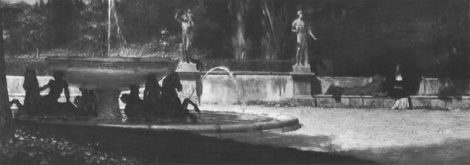 fig. 10
Lawrence Alma-Tadema, Roman gardens, 1877, The Hague, Museum Mesdag though the interior cannot be identified with theirs. In the months before and after their wedding he portrayed his wife several times, but eventually stopped for fear that he might ‘paint her out of my life.’Ga naar voetnoot68 Despite her typically English demeanour, Laura often modelled for Alma-Tadema's Roman scenes. In this portrait she wears her hair up, à l'antique. In 1877 Mesdag bought the narrow, horizontal Roman gardens, described in Alma-Tadema's list of opus numbers as ‘A pannel [sic] for mr. H.W. Mesdag's Studio door’ (fig. 10). Still mounted on the original English stretcher, the painting never served this particular purpose. Alma-Tadema used parts of the picture more than once in other contexts.Ga naar voetnoot69 Roman gardens is a capriccio in which the painter combined various individual elements. The background, with statues of Hermes (Rome, Vatican Museum) and Hercules, and the fountain, were inspired by the Villa Borghese. Mesdag's estate also included a watercolour and the original drawing for the menu in honour of his 70th birthday (fig. 6), both by Alma-Tadema. | |
Laura and Nellie EppsMesdag also owned several works by Laura Tadema. Laura and her sister Ellen (Nellie) Epps (1850-1929) belonged to a London family known as ‘Epps the chemists,’ in token of the fact that their grandfather, father and uncle were pioneers in the field of homeopathic medicine. Laura started out studying drawing under Ford Madox Brown, then took lessons from her future husband. She painted primarily flower still lifes and women and children in a style reminiscent of the 17th-century Dutch masters of the high-gloss finish, known as fijnschilders. Her predilection for this period is further evidenced by the 17th-century Dutch furnishing of her studio. The mirror of 1872 (fig. 11) is one of Laura's early efforts. This finely painted still life contains a self-portrait at the easel seen as a reflection in the mirror. The work is essentially a double portrait, Alma-Tadema's presence being symbolised by the tulip. In another double portrait, this one by Alma-Tadema himself, dating from 1871 (Leeuwarden, Fries Museum), a tulip also serves as an allusion to his nationality, while the rose signifies Laura's English background. The still life with crocuses against a Japanese tray also dates from 1872 (fig. 12). The contents of Mesdag's residence that were sold at auction included two more paintings and a watercolour by Laura. Like her sister, Nellie Epps also took lessons from Ford Madox Brown and then from Alma-Tadema. In 1875 she married the writer, poet and literary critic Edmund William Gosse, whom she had met at one of the Pre-Raphaelite | |
[pagina 71]
| |
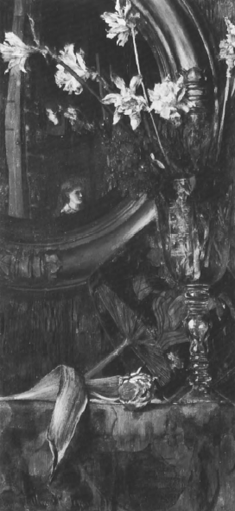 fig. 11
Laura Tadema-Epps, The mirror, 1872, The Hague, Museum Mesdag  fig. 12
Laura Tadema-Epps, Still life, 1872, The Hague, Museum Mesdag gatherings at Brown's house.Ga naar voetnoot70 The organisation of their wedding was left entirely to the Alma-Tademas, to whom the couple remained close for the rest of their lives. Through Alma-Tadema, Gosse became acquainted with his Dutch colleague Carel Vosmaer. Little is known about Nellie's painted oeuvre, which must have consisted primarily of landscapes. Mesdag owned two of her pictures. One of them - sold after his death and presently in private hands (fig. 13) - is a portrait of Laura Tadema emerging from her bathroom in Townshend House. Alma-Tadema's influence is manifest in the meticulous rendering of detail. The work gives us a glimpse of the sumptuous interior, with a large, 17th-century Dutch linen cupboard, rugs, flowered wallpaper, pictures and a basket of keys on the chair. Alma-Tadema had taken the cupboard with him when he left Belgium. Together with a matching bedstead, it figures in his A birthchamber, 17th century (London, Victoria and Albert Museum) of 1869.Ga naar voetnoot71 Alma-Tadema's collection of old Dutch cupboards was destroyed in the aforementioned explosion of a gunpowder ship in 1874. With what remained, he furnished the room in Townshend House known as the Panel Chamber. | |
[pagina 72]
| |
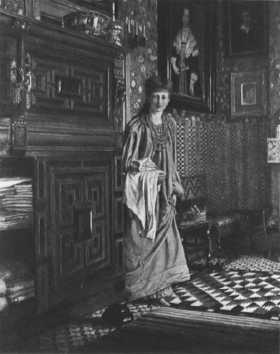 fig. 13
Nellie Gosse-Epps, Laura Tadema in Townshend House, c. 1873, Peize, Dr G. Overdiep The picture by Nellie Epps in the Museum Mesdag was probably painted especially for Mesdag and his wife (fig. 14). It shows the Hall in Townshend House, a ‘salon in which two columns enhance the impression of a Pompeiian casa.’Ga naar voetnoot72 The precise rendering of every detail must have reminded Mesdag of his own early oeuvre, such as the Interior (fig. 1). Both of Alma-Tadema's daughters figure in the picture: Laurence appears behind her younger sister Anna (cf. fig. 16). That same year, 1873, Alma-Tadema painted their portrait (Amsterdam, Van Gogh Museum; see also pp. 182, 194). The picture seen in the background of Hall in Townshend House is an early work by Mesdag belonging to the series of streets he made under Alma-Tadema's guidance (fig. 15). Painted in 1867 or 1868, it hung at first in Alma-Tadema's studio.Ga naar voetnoot73 Whether Alma-Tadema purchased the picture or received it as a gift is not known; after his death it was sold along with the rest of his estate.Ga naar voetnoot74 Several authors have called it a curiosity from the first stage of Mesdag's career. According to Vosmaer, it was prompted by Alma-Tadema's advice ‘to study whatever he saw before him strictly and faithfully’ during the winter | |
[pagina 73]
| |
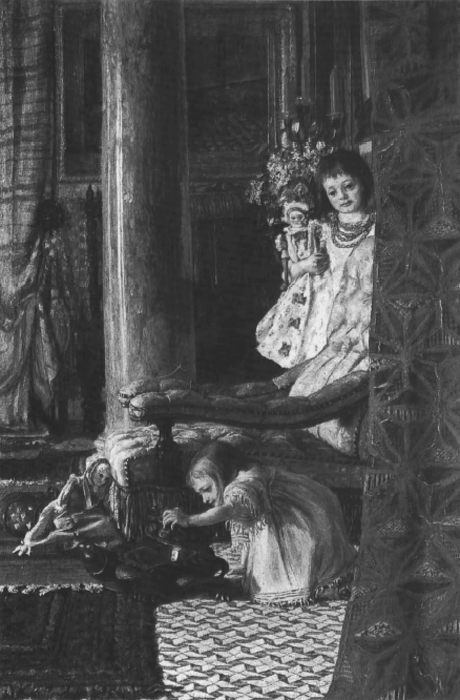 fig. 14
Nellie Gosse-Epps, Hall in Townshend House, 1873, The Hague, Museum Mesdag | |
[pagina 74]
| |
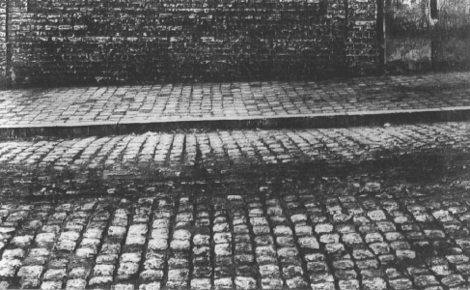 fig. 15
Hendrik Willem Mesdag, A street, 1867 or 1868, present location unknown 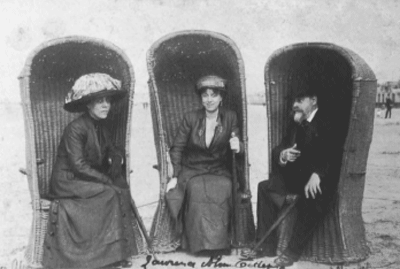 fig. 16
Lawrence Alma-Tadema with his two daughters Anna (left) and Laurence, c. 1910, The Hague, Panorama Mesdag | |
[pagina 75]
| |
months, when it was impossible to work outside.Ga naar voetnoot75 But the most delightful anecdote about the canvas was recorded by Alma-Tadema himself, in a letter to Mesdag of 1868: ‘They've finally begun paving our street; a frightful racket, as you can imagine. [...] Speaking of streets, a few days ago while I was upstairs sitting [in my studio] and staring, and my eldest daughter was keeping me company, she said to me - Papa, est-ce qu'il n'y a donc jamais du monde qui passe là? and pointed to your street study.’Ga naar voetnoot76 After Mesdag became famous, his fluent brushwork was associated with Roelofs's sketchlike manner more often than it was with Alma-Tadema's fine touch. Yet Alma-Tadema thought he should also receive some of the credit for Mesdag's success. As he put it rather acidly in 1909, ‘those [journals] always give such peculiar information that it's impossible to imagine where they get it. I remember that in one or two of those very favourable articles about Sientje [written after her death], you were always called a pupil of Roelofs.’Ga naar voetnoot77 Alma-Tadema was right. Mesdag was indeed greatly indebted to his cousin, who not only taught him the foundations of art but also helped to form his taste. Moreover, it was through Alma-Tadema that Mesdag became known in England. Although contact between the two artists was most intensive around 1870, they were in fact lifelong friends. |
|

